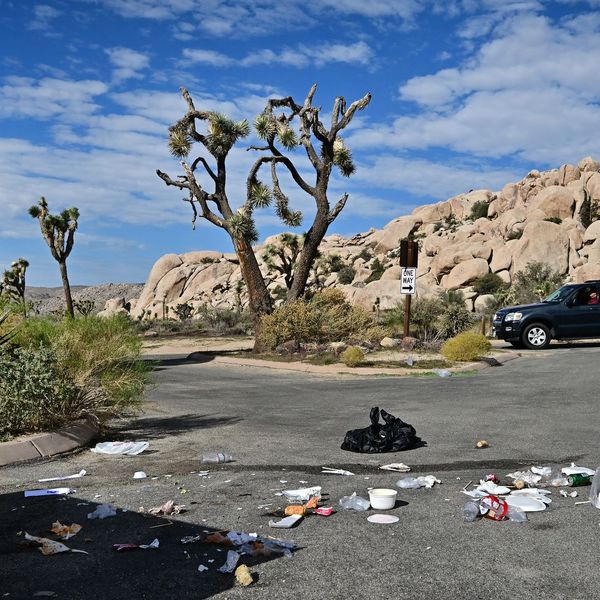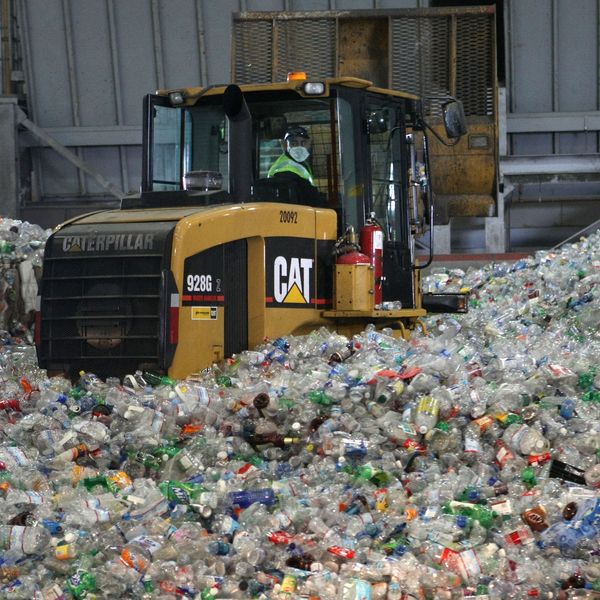Thanks to Industrial Pollution, 90 Percent of Seabirds Have Plastic in Guts
'I have seen everything from cigarette lighters ... to bottle caps to model cars. I've found toys.'
Up to 90 percent of seabirds are likely to have plastic in their guts, and the risk of ingestion is growing--a result of ever-increasing industrial pollution in the world's oceans, according to a new study published Monday.
Seabirds are particularly vulnerable to plastic ingestion due to their habits of eating floating particles that they mistake for fish eggs, state the authors--a trio of Australian scientists who studied 186 species around the world. The report, published in the Proceedings of the National Academy of Sciences journal, analyzed previous data on seabirds' plastic consumption and used computer models to update those figures, extrapolating that "the ingestion rate would reach 90% of individuals if these studies were conducted today."
"It's pretty astronomical," co-author Denise Hardesty told Al Jazeera. "In the next 11 years we will make as much plastic as has been made since industrial plastic production began in the 1950s."
In one case outlined in the report, a short-tailed shearwater bird was found with an entire glowstick and three balloons in its gut.
"I have seen everything from cigarette lighters ... to bottle caps to model cars. I've found toys," Hardesty added.
With industrial production expected to increase, the authors found, plastic ingestion among seabirds will rise in tandem--including in unexpected places.
"The highest area of expected impact occurs at the Southern Ocean boundary in the Tasman Sea between Australia and New Zealand, which contrasts with previous work identifying this area as having low anthropogenic pressures and concentrations of marine debris," the report states.
As Hardesty explains, that's because those areas have the greatest diversity of seabird species. Meanwhile, other recent scientific reports have also blamed industrial byproduct for the massive amounts of waste that enter the world's oceans every year. The UK alone produces 80 tons of microplastic just from cosmetics, while the Netherlands-based group Ocean Cleanup reported that the "Great Pacific Garbage Patch" may be the most polluted marine area in the world.
"I've studied plastic in all the world's oceans, but never seen any area as polluted as the Great Pacific Garbage Patch," Dr. Julia Reisser, lead oceanographer at The Ocean Cleanup, said last week. "With every trawl we completed, thousands of miles from land, we just found lots and lots of plastic."
But targeted efforts to keep plastic out of oceans is one of the most important and effective methods of preventing the crisis from escalating, Hardesty continued. In Europe, reducing plastic particles in the ocean through cleanup programs and incentives for manufacturers to use recyclable materials, among other endeavors, has already helped one of the species included in the study--the northern fulmar--decrease its intake of such microwaste.
The authors of Monday's study conclude that "plastics ingestion is increasing in seabirds, that it will reach 99% of all species by 2050, and that effective waste management can reduce this threat."
An Urgent Message From Our Co-Founder
Dear Common Dreams reader, The U.S. is on a fast track to authoritarianism like nothing I've ever seen. Meanwhile, corporate news outlets are utterly capitulating to Trump, twisting their coverage to avoid drawing his ire while lining up to stuff cash in his pockets. That's why I believe that Common Dreams is doing the best and most consequential reporting that we've ever done. Our small but mighty team is a progressive reporting powerhouse, covering the news every day that the corporate media never will. Our mission has always been simple: To inform. To inspire. And to ignite change for the common good. Now here's the key piece that I want all our readers to understand: None of this would be possible without your financial support. That's not just some fundraising cliche. It's the absolute and literal truth. We don't accept corporate advertising and never will. We don't have a paywall because we don't think people should be blocked from critical news based on their ability to pay. Everything we do is funded by the donations of readers like you. Will you donate now to help power the nonprofit, independent reporting of Common Dreams? Thank you for being a vital member of our community. Together, we can keep independent journalism alive when it’s needed most. - Craig Brown, Co-founder |
Up to 90 percent of seabirds are likely to have plastic in their guts, and the risk of ingestion is growing--a result of ever-increasing industrial pollution in the world's oceans, according to a new study published Monday.
Seabirds are particularly vulnerable to plastic ingestion due to their habits of eating floating particles that they mistake for fish eggs, state the authors--a trio of Australian scientists who studied 186 species around the world. The report, published in the Proceedings of the National Academy of Sciences journal, analyzed previous data on seabirds' plastic consumption and used computer models to update those figures, extrapolating that "the ingestion rate would reach 90% of individuals if these studies were conducted today."
"It's pretty astronomical," co-author Denise Hardesty told Al Jazeera. "In the next 11 years we will make as much plastic as has been made since industrial plastic production began in the 1950s."
In one case outlined in the report, a short-tailed shearwater bird was found with an entire glowstick and three balloons in its gut.
"I have seen everything from cigarette lighters ... to bottle caps to model cars. I've found toys," Hardesty added.
With industrial production expected to increase, the authors found, plastic ingestion among seabirds will rise in tandem--including in unexpected places.
"The highest area of expected impact occurs at the Southern Ocean boundary in the Tasman Sea between Australia and New Zealand, which contrasts with previous work identifying this area as having low anthropogenic pressures and concentrations of marine debris," the report states.
As Hardesty explains, that's because those areas have the greatest diversity of seabird species. Meanwhile, other recent scientific reports have also blamed industrial byproduct for the massive amounts of waste that enter the world's oceans every year. The UK alone produces 80 tons of microplastic just from cosmetics, while the Netherlands-based group Ocean Cleanup reported that the "Great Pacific Garbage Patch" may be the most polluted marine area in the world.
"I've studied plastic in all the world's oceans, but never seen any area as polluted as the Great Pacific Garbage Patch," Dr. Julia Reisser, lead oceanographer at The Ocean Cleanup, said last week. "With every trawl we completed, thousands of miles from land, we just found lots and lots of plastic."
But targeted efforts to keep plastic out of oceans is one of the most important and effective methods of preventing the crisis from escalating, Hardesty continued. In Europe, reducing plastic particles in the ocean through cleanup programs and incentives for manufacturers to use recyclable materials, among other endeavors, has already helped one of the species included in the study--the northern fulmar--decrease its intake of such microwaste.
The authors of Monday's study conclude that "plastics ingestion is increasing in seabirds, that it will reach 99% of all species by 2050, and that effective waste management can reduce this threat."
Up to 90 percent of seabirds are likely to have plastic in their guts, and the risk of ingestion is growing--a result of ever-increasing industrial pollution in the world's oceans, according to a new study published Monday.
Seabirds are particularly vulnerable to plastic ingestion due to their habits of eating floating particles that they mistake for fish eggs, state the authors--a trio of Australian scientists who studied 186 species around the world. The report, published in the Proceedings of the National Academy of Sciences journal, analyzed previous data on seabirds' plastic consumption and used computer models to update those figures, extrapolating that "the ingestion rate would reach 90% of individuals if these studies were conducted today."
"It's pretty astronomical," co-author Denise Hardesty told Al Jazeera. "In the next 11 years we will make as much plastic as has been made since industrial plastic production began in the 1950s."
In one case outlined in the report, a short-tailed shearwater bird was found with an entire glowstick and three balloons in its gut.
"I have seen everything from cigarette lighters ... to bottle caps to model cars. I've found toys," Hardesty added.
With industrial production expected to increase, the authors found, plastic ingestion among seabirds will rise in tandem--including in unexpected places.
"The highest area of expected impact occurs at the Southern Ocean boundary in the Tasman Sea between Australia and New Zealand, which contrasts with previous work identifying this area as having low anthropogenic pressures and concentrations of marine debris," the report states.
As Hardesty explains, that's because those areas have the greatest diversity of seabird species. Meanwhile, other recent scientific reports have also blamed industrial byproduct for the massive amounts of waste that enter the world's oceans every year. The UK alone produces 80 tons of microplastic just from cosmetics, while the Netherlands-based group Ocean Cleanup reported that the "Great Pacific Garbage Patch" may be the most polluted marine area in the world.
"I've studied plastic in all the world's oceans, but never seen any area as polluted as the Great Pacific Garbage Patch," Dr. Julia Reisser, lead oceanographer at The Ocean Cleanup, said last week. "With every trawl we completed, thousands of miles from land, we just found lots and lots of plastic."
But targeted efforts to keep plastic out of oceans is one of the most important and effective methods of preventing the crisis from escalating, Hardesty continued. In Europe, reducing plastic particles in the ocean through cleanup programs and incentives for manufacturers to use recyclable materials, among other endeavors, has already helped one of the species included in the study--the northern fulmar--decrease its intake of such microwaste.
The authors of Monday's study conclude that "plastics ingestion is increasing in seabirds, that it will reach 99% of all species by 2050, and that effective waste management can reduce this threat."

